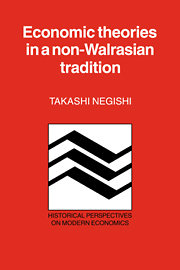Book contents
- Frontmatter
- Contents
- Preface
- 1 Anti-neoclassical or non-Walrasian economic theories
- Part I Increasing returns and diminishing cost
- Part II Wages and profit
- 6 Conditions for the wages fund doctrine and Mill's recantation of it
- 7 Marx and exploitations in production and in circulation
- 8 Marx's dichotomy between exploitation and redistribution of surplus products
- 9 Böhm-Bawerk and the positive rate of interest in a stationary state
- Part III International trade and investment
- Part IV Markets and money
- Notes
- References
- Author index
- Subject index
8 - Marx's dichotomy between exploitation and redistribution of surplus products
from Part II - Wages and profit
Published online by Cambridge University Press: 21 September 2009
- Frontmatter
- Contents
- Preface
- 1 Anti-neoclassical or non-Walrasian economic theories
- Part I Increasing returns and diminishing cost
- Part II Wages and profit
- 6 Conditions for the wages fund doctrine and Mill's recantation of it
- 7 Marx and exploitations in production and in circulation
- 8 Marx's dichotomy between exploitation and redistribution of surplus products
- 9 Böhm-Bawerk and the positive rate of interest in a stationary state
- Part III International trade and investment
- Part IV Markets and money
- Notes
- References
- Author index
- Subject index
Summary
Böhm-Bawerk (1975) claimed that a contradiction exists between volume I and volume III of Marx's Das Kapital, supporting that claim by interpreting arguments in these two volumes as two different theories of relative prices (see Chapter 7). In view of the reply to Böhm-Bawerk given by Hilferding (1975, pp. 160–61) that in volume I, “Marx's concern is with the value newly created within a period of production, and with the ratio in which this newly created value is distributed between the working class and the capitalist class, thus furnishing the revenues of two great classes,” however, it is more appropriate to say that there is a dichotomy between the theory of distribution of income between property owners and wage earners (the theory of value) in volume I and the theory of distribution among property owners (the theory of prices of production and the theory of rent) in volume III.
Like Walras and many other neoclassical economists who started with the simple real models of exchange and of production and later introduced money into consideration, Marx also started with the simple world of value and rate of surplus value (volume I) and later introduced the price of production and the equality of rates of profit, and rent and landownership (volume III). Such a two-step approach, source of the dichotomy, is certainly useful since we can separate a simpler, but more important problem from other, more complex problems and can study the former without being bothered by the latter.
- Type
- Chapter
- Information
- Economic Theories in a Non-Walrasian Tradition , pp. 89 - 100Publisher: Cambridge University PressPrint publication year: 1985

